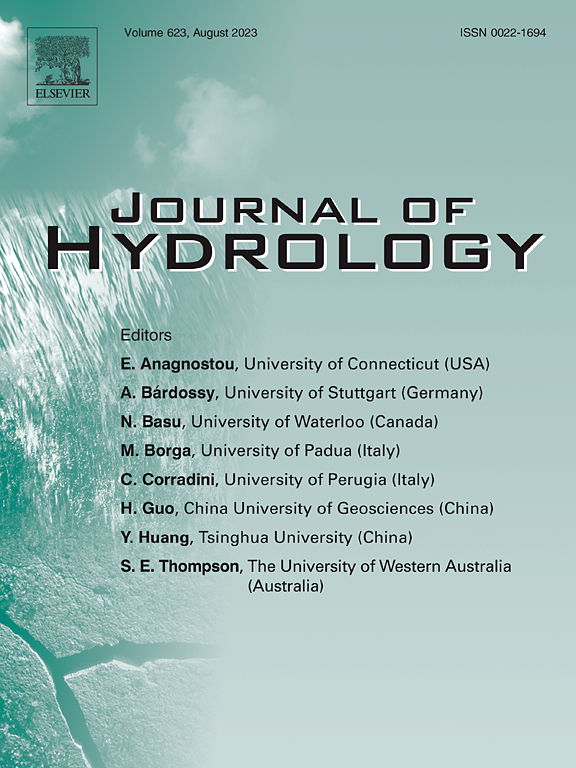Impact of land cover and sediments on GHG emissions from Indonesian rivers
IF 5.9
1区 地球科学
Q1 ENGINEERING, CIVIL
引用次数: 0
Abstract
The evasion of methane (CH4) and carbon dioxide (CO2) from tropical rivers represents a substantial contribution, where land covers and riverbed biogeochemistry significantly apply in situ controls. However, CH4 and CO2 emissions from tropical rivers are less constrained. Riverine emissions from Indonesia—the world’s most populous tropical island—are undergoing rapid land cover changes and have not been adequately studied. Here, we investigated the spatial variations of concentration and fluxes of CH4 and CO2 from rivers with different land cover types in Yogyakarta. Our result showed an intense CH4 ebullition rate (94.51 ± 126.09 mmol m−2 d−1) approximately 47 times higher than the estimated global mean value for streams and rivers. Elevated ebullition rates were controlled by enriched clayey sediments through agricultural activities, which increase organic carbon availability, foster reduced conditions, and support methanogenic archaea. CO2 diffusion was preponderant in agricultural-dominated rivers. CO2 emissions were governed by sediment texture, microbial respiration, and lateral CO2 input from river corridors. These findings highlight the role of the target river in shaping CH4 and CO2 dynamics, particularly the impact of agricultural practices and sedimentation. This study not only tackles the scarcity of data on riverine greenhouse gas emissions in Indonesia but also highlights the importance of managing agricultural activities and sedimentary processes to mitigate CH4 and CO2 in tropical systems.

土地覆盖和沉积物对印尼河流温室气体排放的影响
从热带河流中逃逸的甲烷(CH4)和二氧化碳(CO2)是一个重要的贡献,在那里,土地覆盖和河床生物地球化学显著地适用于原位控制。然而,来自热带河流的CH4和CO2排放受到的限制较少。印度尼西亚是世界上人口最多的热带岛屿,它的河流排放正在经历快速的土地覆盖变化,而且还没有得到充分的研究。本文研究了日惹市不同土地覆盖类型河流CH4和CO2浓度及通量的空间变化。我们的结果表明,强烈的CH4沸腾率(94.51 ± 126.09 mmol m−2 d−1)比估计的全球溪流和河流平均值高约47倍。通过农业活动,丰富的粘土沉积物控制了沸腾速率的升高,这增加了有机碳的有效性,促进了还原条件,并支持产甲烷的古细菌。CO2扩散在以农业为主的河流中占优势。CO2排放受沉积物结构、微生物呼吸和河流廊道侧向CO2输入的控制。这些发现强调了目标河流在形成CH4和CO2动态方面的作用,特别是农业实践和沉积的影响。这项研究不仅解决了印度尼西亚河流温室气体排放数据缺乏的问题,而且还强调了管理农业活动和沉积过程以减少热带系统中CH4和CO2的重要性
本文章由计算机程序翻译,如有差异,请以英文原文为准。
求助全文
约1分钟内获得全文
求助全文
来源期刊

Journal of Hydrology
地学-地球科学综合
CiteScore
11.00
自引率
12.50%
发文量
1309
审稿时长
7.5 months
期刊介绍:
The Journal of Hydrology publishes original research papers and comprehensive reviews in all the subfields of the hydrological sciences including water based management and policy issues that impact on economics and society. These comprise, but are not limited to the physical, chemical, biogeochemical, stochastic and systems aspects of surface and groundwater hydrology, hydrometeorology and hydrogeology. Relevant topics incorporating the insights and methodologies of disciplines such as climatology, water resource systems, hydraulics, agrohydrology, geomorphology, soil science, instrumentation and remote sensing, civil and environmental engineering are included. Social science perspectives on hydrological problems such as resource and ecological economics, environmental sociology, psychology and behavioural science, management and policy analysis are also invited. Multi-and interdisciplinary analyses of hydrological problems are within scope. The science published in the Journal of Hydrology is relevant to catchment scales rather than exclusively to a local scale or site.
 求助内容:
求助内容: 应助结果提醒方式:
应助结果提醒方式:


